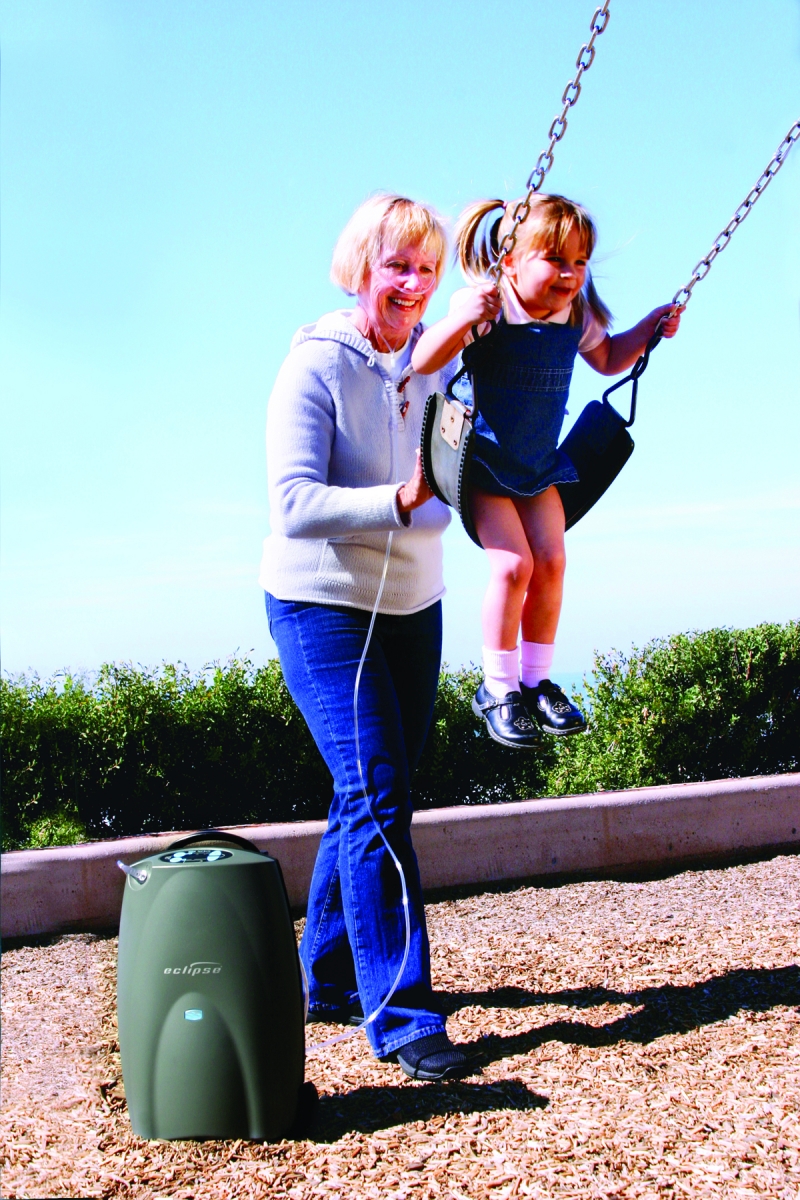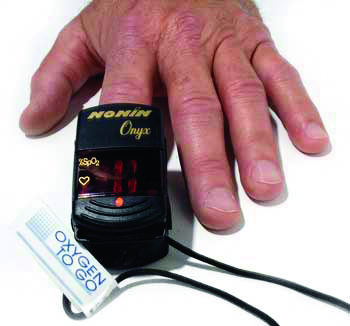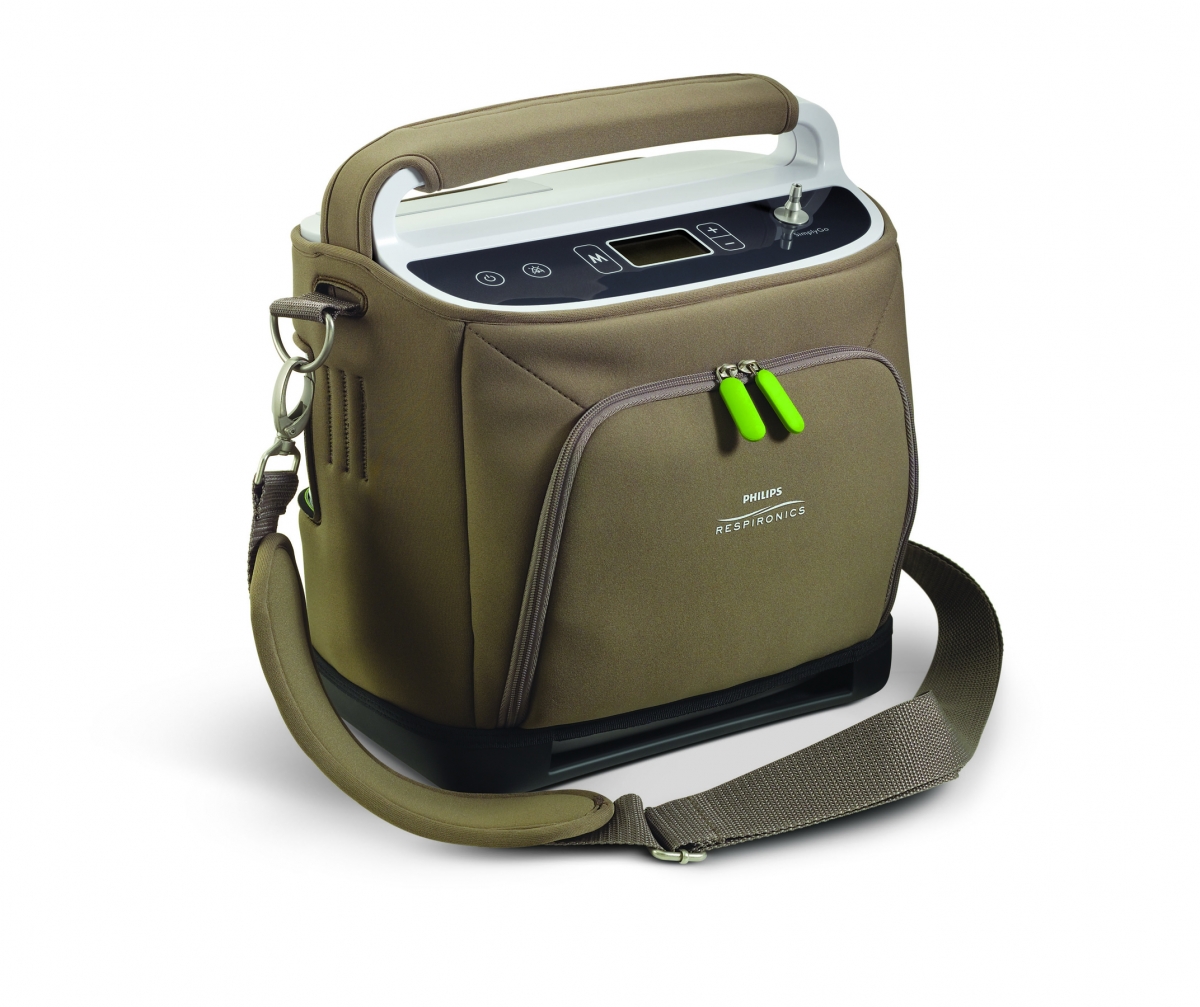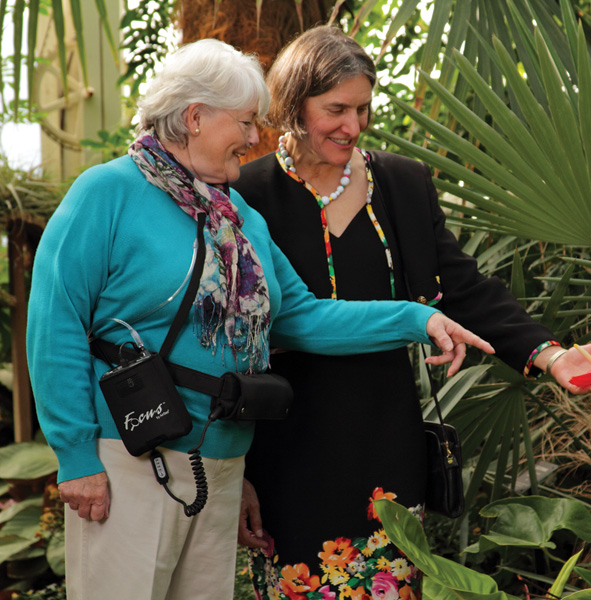Portable oxygen equipment has only been on the market for about seven years. It is a fragmented sector, with a dozen or so manufacturers that currently supply portable oxygen concentrators (POCs). Reliability has been a concern in the past, but the newest generation of products is more dependable and opens the door for a shift away from the traditional HME model of oxygen delivery.
Compared with the mature technology of stationary oxygen concentrators, it is unrealistic to expect the same level of reliability in a portable device, according to Chris LaPorte, Invacare’s business manager for portable oxygen concentrators. It’s not surprising that in the current market, the reliability of POCs has not been what providers had hoped, LaPorte says.
“The stationary concentrator is a more simplistic device and very reliable. You turn it on and it runs,” he says. In contrast, a portable concentrator has computer components, variable settings and power inputs, encounters shifting environments and can even get “banged up” because of its portability.
“We have already moved forward with reliability since POCs were introduced seven years ago. The current products are the best ever, and future products will be even more robust,” LaPorte says. Improvements include changes to mounting systems and connection points to better withstand use. “Smaller devices take a system that’s tried and true and squeeze it into a much smaller device, and it’s a challenge,” he adds.
The portable oxygen sector now offers products in smaller, lighter packages that are more powerful and more clinically and operationally robust. “There are always tradeoffs,” he says. Battery life is one tradeoff, and development continues on batteries that last longer and weigh less. Battery developments from other markets, such as cell phones and laptops, are driving economies of scale and could benefit oxygen concentrators in the future, according to LaPorte.
“Hopefully, down the road you will see batteries that weigh less and are more powerful, or that weigh the same and have three times the life,” he says.
Invacare offers both the SOLO2 portable continuous flow oxygen concentrator, which weighs about 20 pounds and is transported using a wheeled cart. The XPO2 concentrator, which provides pulsed-dose only, is a six-pound device that can be carried over the shoulder or in a backpack. In addition to POCs, Invacare also offers a “home fill system” that works with an oxygen concentrator to fill portable cylinders. Invacare developed the device 12 years ago and remains the dominant player.

SeQual’s Eclipse 3 is a small, lightweight and easy to use oxygen concentrator that can provide three liters per minute of continuous flow oxygen and also has a pulse dose setting. The POC is a 24/7 device and can be used as a travel unit (FAA approved), as a stationary unit and as an ambulatory device. The Eclipse 3 offers adjustable patient dose sensitivity and rise time to serve a variety of patient types, matching oxygen delivery to breathing patterns, which vary by disease. SeQual’s AutoSAT technology ensures delivery of a prescription-level bolus of oxygen despite elevated respiratory rates, thus keeping FiO2 levels at a constant, elevated rate. Responding to market trends, by the end of the year, SeQual will introduce a new model of its flagship Eclipse 3 portable oxygen concentrator that is 35 percent smaller and lighter, and that will perform clinically the same. CAIRE also manufactures a line of liquid oxygen reservoirs and liquid oxygen portables for the home health market.
Value Proposition of Nondelivery
The acquisition costs of converting a fleet of oxygen concentrators and tanks to a nondelivery method is intimidating for many DMEs, says Mitchell Yoel, executive vice president of business development and government affairs for Drive Medical. “However, the value proposition of a nondelivery or ‘fewer-delivery’ portable oxygen modality is undeniable when operational costs over time are taken into account,” he says.
Drive Medical offers several cost-effective and practical portable oxygen modalities. Last year Drive acquired Chad Therapeutics and now provides access to a broad and deep line of oxygen conserving devices and offers pneumatic, electronic and disposable reservoir conserving technology. Drive also offers Oxus Reliability Plus, a durable and clinically effective, pulsed-dose portable oxygen concentrator.
Yoel says that oxygen-conserving devices provide the best balance of acquisition cost, clinical efficacy and total cost of ownership. Advances in oxygen conservation are focusing on auto-adjusting technology that caters bolus volume and frequency to the activity level and respiratory rate of a patient. The approach provides better saturation during activity while conserving oxygen during rest. An example is Drive Medical/Chad’s new Evolution Plus electronic oxygen conserver.
Miniaturization of key components, in addition to advancements in lithium battery technologies, are enabling manufacturers to offer much smaller units that are actually a “mini-oxygen producing plant,’” says Kathy O’Brien, marketing and public relations manager for AirSep Corp. Since introducing its first POC in 2001, AirSep’s product line has expanded, and this year the company will introduce a new higher-capacity POC.
The burden of carrying oxygen equipment is the number-one complaint of patients. Lightweight products are an attractive option. “Even putting their oxygen system in a cart can be cumbersome to handle and does not allow them to carry it up flights of stairs,” says O’Brien. AirSep’s Focus portable oxygen concentrator weighs less than two pounds, and it is designed to meet the ambulatory requirements of approximately 80 percent of oxygen patients. “Without a proper lightweight option to fit their need, patients often go without their portable oxygen or remain homebound, neither of which is what clinicians want to see for their patients.”
Providing Oxygen For Air Travel
Accommodating travel is one application for portable oxygen. OxygenToGo specializes in providing oxygen to travelers, specifically air travelers. The physician-owned company was founded seven years ago by Dr. Brent Blue to fill the void when domestic airlines began phasing out the practice of providing oxygen tanks to travelers. Now OxygenToGo works with airlines, HME providers and directly with travelers to provide oxygen in accordance with Federal Aviation Administration (FAA) regulations. These regulations include the use of approved devices and battery duration equaling 150 percent of the flight time.

Delta Airlines refers travelers to OxygenToGo for flight clearance, a service the company offers in exchange for the possibility of additional business if there are gaps to fill, such as insufficient battery life or equipment needs. OxygenToGo provides cash-only service and is paid directly by the traveler. The company works with HME providers to serve their customers’ travel needs without presenting a competitive threat to the provider’s ongoing customer relationships. Most of the business is the result of repeat referrals, including HME providers, travel agents and even device manufacturers.
David Hughes, director of operations for OxygenToGo, says portable oxygen technology developments are a “new frontier,” and notes that some devices on the market have an unacceptably high failure rate. “There have been devices that we don’t carry,” says Hughes. He says he sees about a dozen devices on the market, one of which is “a complete failure.”
Improvements in POCs include better user interfaces, smaller size, portability and improvements in battery duration. The newer second generation products are showing some exciting improvements. SimplyGo, a new small device from Philips Respironics that offers continuous flow oxygen, has strong market potential, Hughes says.

Some portable devices are designed for home use, possibly for a day trip, but are not designed with airline travel in mind. Some HME providers do not truly understand the capabilities of the devices they provide, says Hughes, who has experienced the misunderstanding firsthand when evaluating what a patient needs for an airline trip. “I have been on the phone with the customer and their HME shouting at me that the device performs a function that it doesn’t,” he says.
HME providers should also know their devices’ weaknesses and compensate for them. For example, Hughes says his company modifies most of the carry bags for POC devices to increase airflow. There is also a battery interface on one device that is prone to failure, a problem his company solves by applying adhesive to a strategic spot to keep a key component from breaking.
Comparing POCs to mass-market technologies, such as VCRs and DVDs, Hughes says he sees about a 10-year period between introduction and full market adoption. He predicts the next three years or so will see greater market adoption. “It depends on the manufacturers of the devices,” he says. “It’s the free market at its best. There will be companies that will succeed or fail.” Other factors in the market are the financial and political aspects of Medicare and general caution about abandoning an older model. “A lot of people are pushing to keep the status quo,” he says.
“Fear in the DME world” about portable oxygen devices has led to overly negative and critical comments about POC devices, Hughes says. He attributes the negativity to concern about a threat to the profitable recurring revenue business model of home delivery. “Medicare won’t move fast, but at some point the model of a POC for home use or for the patient’s use during the day could diminish DME providers’ ability to capture the business,” he says.
The best target for education about POCs is the patient, Hughes says. It’s hard to get physicians or referral sources interested in new products, but convincing the patient of the benefits will also get that message back to the doctor. “The patient drives it, and they can push the doctor,” he says.
The Long View
Providers can be more successful promoting portable oxygen products by illustrating to patients and their caregivers how quality of life can be improved, in particular with the appropriate lightweight solution that provides mobility for extended periods away from home. Rental is a more advantageous option for both the provider and the patient, says O’Brien of AirSep. For the provider, renting oxygen concentrators creates greater revenue and profits throughout the equipment’s useful life, compared to the one-time profit generated by a sale. “Many more patients can afford a smaller per-month payment than an outright purchase,” says O’Brien. Medicare reimburses for portable oxygen concentrators as part of the newer OGPE category.
Embracing a nondelivery model can save costs for providers. This relates to escalating fuel costs, says O’Brien. Offering POCs solves travel and logistics concerns that affect the HME provider’s bottom line and is an effective and welcome option for patients.

Choosing the right oxygen supplier often comes down to support, says LaPorte. “Who will be able to best support the provider to grow and be a successful company? Providers make a choice according to which suppliers can help their business grow.”
In general, in the oxygen market, approximately 75 or 80 percent of patients are supported by Medicare. The first round of competitive bidding lowered the allowables for portable oxygen significantly. Lower upsides have discouraged some providers from investing in portable oxygen. “A longer-term view might be: Is this something that will help me retain patients?” LaPorte says.
A broader understanding of the economics of portable oxygen can help to ease concerns about higher equipment costs, he adds. Providers now deal with increasing operational costs related to filling, delivery and regulatory aspects of oxygen cylinders and investments in delivery trucks, which will all go away. “If you’re a provider and you can fix those costs by investing in technology, cash flow will look better month to month with fewer variable costs,” says LaPorte.
To make more money on portable oxygen equipment, LaPorte suggests providers invest in public relations and advertising, including expanded showrooms, websites and social networking. It’s also helpful to invest time with physicians and referral sources to educate them on what POCs can do for patients.
LaPorte also recommends that HME providers open their minds to working with nontraditional partners, such as travel agents, who might be interested in portable oxygen to help a customer realize future travel plans. He also says providers should support schools and community events—anything to get their name on the minds of potential medical device consumers.
Some customers are opting to buy a portable concentrator in a cash sale to complement their stationary device. POCs are being sold for $4,000 or $5,000 on the Internet. Baby Boomers with disposable income may opt to pay cash for a POC, says LaPorte. Research suggests those who walk when using oxygen tend to live longer. Simply speaking, portable oxygen could extend life expectancy. Portable concentrators are a more flexible and dependable system than relying on the “ticking clock” of a portable cylinder, LaPorte says.
Beware of Product Claims
New product development also includes high-technology POCs with increasingly effective conservation technology, Drive Medical’s Yoel says. “A POC is intended for use primarily during activity, a time when respiratory rate often increases,” he says. “Extensive data shows that well-designed pulsed-dose units can oxygenate patients as well as or better than continuous flow.”
The Oxus Reliability Plus by Chad uses a sensitive, accurate and fast-delivery oxygen conserving device combined with uniform pulse delivery algorithm to provide more oxygen with increasing respiratory rate. Flexible financing programs make the devices an attractive and cash-flow-positive solution for providers, Yoel says.
Yoel suggests providers maintain a healthy level of skepticism generally about product claims in the market. “Simply because a particular product is available doesn’t mean it works,” he says. POC claims might include the lightest weight, longest battery life, smallest footprint, etc. “The assumption is that they actually put out a therapeutic dose of oxygen to saturate patients during activity. Before providers put their reputations on the line by promoting a particular product, they should feel confident that the product can serve its core function. A pulmonologist will care less about the portability of a device if patient after patient walks into the office saturating in the 80s.”
Changing portable oxygen modalities are shifting the role of HME providers from that of “order-filler” to more of a consultative expert on equipment, according to Yoel. HME providers and manufacturers are the only equipment experts in the health care supply chain, so providers must now offer value and information to referral sources. “A provider can work with referral sources to match products to patients and solve saturation and oxygen conservation problems together,” he says.
Reliability and durability of portable oxygen equipment are critical components related to total cost of ownership and also to branding, says Yoel. “When a POC requires a service call, the DME provider not only incurs a real and significant cost, but also a brand nightmare. If the referral source gets a call from a dissatisfied patient, fair or not, it will likely impact the referral source’s perception of the provider.”




